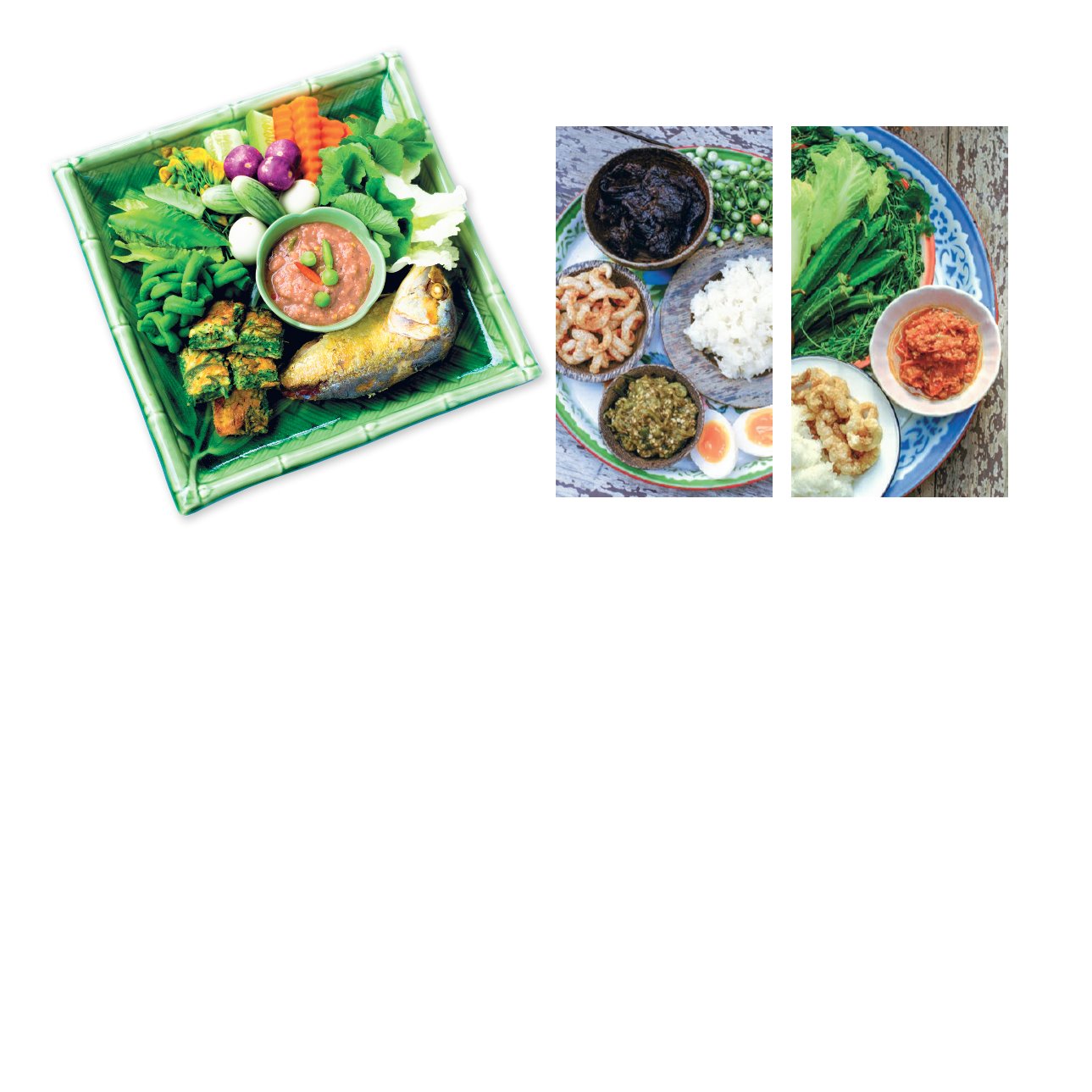

142
|
Culture Ways of Life and Wisdom
Due to the strong flavor of Nam Prik, Thai people generally eat Nam Prik along with seasonal vegetables.
For example, during the season of young tamarind, it will be used for cooking for Nam Prik Makam, which is
served along with fresh vegetable such as eggplant, cucumber, string bean, and white turmeric; and with side
dishes such as fried salted gourami (Pla Salid) and salted egg. Similarly, in the Northern region, Nam Prik Ong is
cooked when little sour tomato is in season, is served along and also with fresh vegetables such as cucumber,
string bean and winged bean; with scalded vegetables for example; hummingbird vegetable, pumpkin, and
calabash. In addition, as Thais are highly selective on their choices of consumption, they like to match their side
dishes with different types of Nam Prik in order to enhance more toothsome flavor. As a result, for example in
the Central region, Nam Prik Kapi is served with Acacia, white turmeric, cucumber, Acacia Pennata omelets
(Cha-Om Omelets) along with fried mackerel (Pla-too) as side dish. In the Southern region,
“Nam Choup Kapi”
(the Southern spicy shrimp paste) is served together with bitter bean (Sator), djenkol bean (Luk Nieng), boiled
and pickled vegetables.
The different lifestyles and living conditions reflect the varieties of tastes, ingredients, and cooking methods
in each region. All ingredients of Northern Nam Prik are grilled or roasted and then seasoned with salt. Hence,
it is not as spicy as the other regions. Instead of shrimp paste, fermented soybean is added to enhance the flavor
of Northern Nam Prik such as Nam Prik Num, Nam Prik Ong, Nam Prik Nam Poo, Nam Prik Nampu, Nam Prik
Nampak, Nam Prik Kapmoo, and Nam Prik Moomok. In the Isan region, there are three types of Northeastern
Nam Prik, cooked with fermented fish (Plara) as the main ingredient:
“Pon”
,
“Jaew”
,and
“Choup”
. Firstly,
“Pon”
is a thick kind of Nam Prik, and served along with vegetables. This kind of Nam Prik consists of dried chilli, shallot,
garlic—which is pounded or mashed together with fish, mushroom, or meat and seasoned with fermented fish
in order to make thicker liquid for dipping with vegetable such as Pon Plara, Pon Pla Nueng, and Pon Platoo.
Secondly,
“Jaew”
is original Nam Prik of Isan, and served along with vegetable and meat. Fermented fish and
chilli are the main ingredients of Jaew. And lastly,
“Soup”
is another kind of Nam Prik in Isan region, adapted
from Jaew since the word
“Soup”
came from
“Choup”
meaning
“dip”
. There, the word
“Jum and Jim”
also
means adding vegetables into Jaew sauce and seasoned with ground roasted rice.
•
Nam Prik Num
• Nam Prik Ong
•
Nam Prik Kapi
“
Nam Prik also has medical
properties because of its
herbal ingredients for
instance ginger, galangal,
lemongrass, chilli, and
shallot. It is even more
nutritious if eaten together
with fresh vegetables which
have antioxidants that help
prevent aging and reduce
the risk of cancer, heart
disease, stroke, and brain
diseases.
”


















